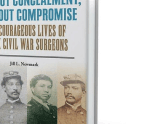
One of the many iconic photographs taken on the Gettysburg battlefield by Alexander Gardner’s photographic team was the heartbreaking image of the bloated corpse of a horse. The unfortunate animal was one of the wheel pair, and it died still harnessed to a shattered limber, the deadly contents of the limber chest scattered about. Freshly covered graves are nearby, possibly those of the drivers and artillerymen who manned the light 12-pounder Napoleon cannon.
Through the haze, a line of army wagons and artillery vehicles are parked behind the wreckage, trees showing just above the white canvas covers. While the appalling destruction of battle remains untouched where it fell, the war goes on as soldiers wait in the background for orders to continue the pursuit of the Army of Northern Virginia to the Potomac River.
Gardner’s photographers took the image on or about July 6, 1863. When Gardner published his Photographic Sketchbook of the War later in 1863, he titled the image “Unfit for Service.” The scene conveys the traumatic image of death and destruction of man and animal alike, and is a stoic reminder of the cost of war.
Aside from its poignancy, the image leaves some questions unanswered. To what battery did this limber and horse belong? What happened at this location that caused such destruction? How did this wreckage remain untouched for so many days after the battle ended?



Though the image was published in the and as a stereoview after the war, this photograph did not receive widespread (1894). Miller’s (1911) published a much clearer view of the scene that revealed the line of vehicles beyond the wreckage, what appears to be part of an orchard, and, upon closer examination, the roof line and chimney of a house.






